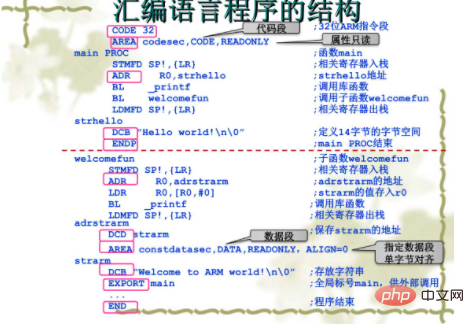What is a symbolic machine language
Assembly language is a symbolic machine language; Assembly language is any low-level language used for electronic computers, microprocessors, microcontrollers or other programmable devices, also known as symbolic language; In assembly language, mnemonics are used to replace the opcodes of machine instructions, and address symbols or labels are used to replace the addresses of instructions or operands.

#The operating environment of this article: Windows 7 system, Dell G3 computer.
What is a symbolic machine language?
Assembly language is a symbolic machine language.
Assembly language is any low-level language used for electronic computers, microprocessors, microcontrollers or other programmable devices, also known as symbolic language. In assembly language, mnemonics are used to replace the opcodes of machine instructions, and address symbols or labels are used to replace the addresses of instructions or operands.
In different devices, assembly language corresponds to different machine language instruction sets, which are converted into machine instructions through the assembly process. There is a one-to-one correspondence between a specific assembly language and a specific machine language instruction set, and they are not directly portable between different platforms.

Extended information:
The characteristic of assembly language is that it is easy to be recognized and executed by the computer. Using it for programming can reduce the space occupied, increase the running speed, and Can directly control the hardware.
It plays an irreplaceable and important position when real-time control is required, but assembly language is more complicated and difficult to program and understand, especially when performing data processing or logical operations, its disadvantages are highlighted. .
High-level language is a user-oriented language that can be more accurately understood by programmers. It has strong expressive ability, many functions, high programming efficiency, fast learning speed, and high degree of automation, so it is more popular. .
For more related knowledge, please visit the FAQ column!
The above is the detailed content of What is a symbolic machine language. For more information, please follow other related articles on the PHP Chinese website!

Hot AI Tools

Undresser.AI Undress
AI-powered app for creating realistic nude photos

AI Clothes Remover
Online AI tool for removing clothes from photos.

Undress AI Tool
Undress images for free

Clothoff.io
AI clothes remover

AI Hentai Generator
Generate AI Hentai for free.

Hot Article

Hot Tools

Notepad++7.3.1
Easy-to-use and free code editor

SublimeText3 Chinese version
Chinese version, very easy to use

Zend Studio 13.0.1
Powerful PHP integrated development environment

Dreamweaver CS6
Visual web development tools

SublimeText3 Mac version
God-level code editing software (SublimeText3)

Hot Topics
 1377
1377
 52
52
 What are the characteristics of machine language, assembly language, and high-level language?
Apr 22, 2021 pm 04:00 PM
What are the characteristics of machine language, assembly language, and high-level language?
Apr 22, 2021 pm 04:00 PM
Characteristics of machine language: difficult to learn, understand, and understand; not universal; requires manual allocation of memory; and runs fastest. The characteristics of assembly language: the execution efficiency of the program is very high, it takes up little storage space, and it runs fast; it lacks versatility and the program is not easy to transplant. Characteristics of high-level languages: easy, certain versatility, and cannot be directly recognized and executed by computers.
 What programming language is used to write programs that can be directly executed by computers?
Mar 24, 2021 pm 05:05 PM
What programming language is used to write programs that can be directly executed by computers?
Mar 24, 2021 pm 05:05 PM
Programs that computers can directly execute are written in "machine language". Machine language is a programming language or instruction code that the machine can directly recognize without translation. Each operation code has a corresponding circuit inside the computer to complete it, or it refers to a programming language that can be directly understood and accepted by the machine without translation. or instruction code.
 What is a computer's instruction set called?
Dec 24, 2020 pm 03:29 PM
What is a computer's instruction set called?
Dec 24, 2020 pm 03:29 PM
The set of instructions for a computer is called "machine language". Machine language is a collection of machine instructions expressed in binary code that a computer can directly recognize and execute; it is the operating function given to the computer by the computer designer through the computer's hardware structure.
 Is machine language a high-level language?
Aug 22, 2023 pm 05:13 PM
Is machine language a high-level language?
Aug 22, 2023 pm 05:13 PM
Machine language is not a high-level language. It is a low-level language used for computer hardware. It interacts directly with the underlying hardware of the computer. Machine language uses binary encoding to represent instructions and data. Each instruction corresponds to an operation or function of the computer hardware. , High-level language is a programming language that is closer to human language, providing higher abstraction capabilities and development efficiency. Machine language and high-level language play different roles in programming, each with their own advantages and applicable scenarios.
 What language can be directly recognized by computers?
Jan 11, 2021 pm 04:20 PM
What language can be directly recognized by computers?
Jan 11, 2021 pm 04:20 PM
Language that can be directly recognized by computers is "machine language". Machine language is a language directly abbreviated by computer instruction code and expressed in binary. It is the only language that a computer can directly recognize and execute.
 What is a set of machine instructions that a microprocessor can complete called?
Aug 22, 2022 pm 04:35 PM
What is a set of machine instructions that a microprocessor can complete called?
Aug 22, 2022 pm 04:35 PM
It's called "machine language". Machine language is a set of machine instructions expressed in binary code that a computer can directly recognize and execute. An instruction is a statement in machine language. It is a set of meaningful binary codes. The basic format of the instruction is the opcode field and the address code field. The opcode specifies the operating nature and function of the instruction, and the address code gives The operand or the address of the operand.
 Why is machine language a language that computers can directly recognize and execute?
Aug 02, 2022 pm 03:12 PM
Why is machine language a language that computers can directly recognize and execute?
Aug 02, 2022 pm 03:12 PM
Because machine language is a set of machine instructions represented by binary code that the computer can directly recognize and execute; this instruction set is called machine code, which is data that the computer's CPU can directly interpret. The hardware structure gives the computer its operational functions.
 What is machine language
Jul 20, 2022 am 10:51 AM
What is machine language
Jul 20, 2022 am 10:51 AM
Machine language is a system of instruction sets; machine language is a programming language or instruction code that can be directly recognized by the machine without translation. Each operation code has a corresponding circuit to complete it inside the computer, or it can be completed without translation. It is a programming language or instruction code that is directly understood and accepted by the machine. Machine language is a formal language used to define computer programs and is used to issue instructions to the computer.



